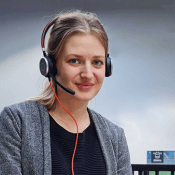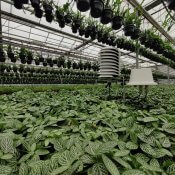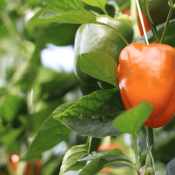We’re capturing data we previously couldn’t: an interview with horticultural consultant Chris Need
Besides directly helping growers directly, we’re seeing the powerful role the 30MHz platform can play in helping growers and consultants communicate and collaborate about crop needs. We spoke with Chris Need, a UK-based horticultural consultant about his work with 30MHz. Here are his observations on the benefits of the data platform, in his own words.
What’s your history in horticulture?
I’m a horticulturalist by training, and have been a consultant, technical and production director in horticulture for 25 years. I started my career at ADAS, the UK’s largest independent provider of agricultural and environmental consultancy. During the organisation’s transition from government department to agency to commercial firm I developed a nationwide customer base in the bedding plant industry. I then got the opportunity to put my technical knowledge into practice in a rapidly expanding business undertaking technical, operations and production director roles at Roundstone Nurseries. I now work as an independent consultant, weaving together my passion for technology and plant science.
Why is agritechnology crucial for growers and consultants?
There are a number of issues on people’s minds in this industry— issues that crop-level insights can help resolve. Petunia distortion and pansy mottle syndrome, for example, are environment-related, but the industry has never really found a fix or a way to control and prevent them. These issues would pop up some years, but not others, and there was never any reliable way to really predict them. That’s been one interesting challenge.
One customer, for example, had a particularly bad problem with petunia distortion last year, which resulted in high levels of waste and product loss. I worked on a project with them this year, which showed both the importance and limitations of some technology. I’d use their computer data, go into the nursery, download the information— export into PDF, analyze, and send it back to them. Needless to say, this was a difficult and clunky way to work. But it did underscore the point that regular contact on environmental conditions is important. We could see the changes to the environment, see the effect of those changes in the environment on the crop, look at the weather going forward, and repeat every week. That kind of regular monitoring informed our ability to change the greenhouse conditions to suit the outside environment: drop temperature when it gets cold, raise temperatures to control VPD or humidity when it gets warm. It’s all about keeping plants active and understanding how they respond to the environment on an ongoing basis. As soon as I saw the 30MHz system, I saw the advantage that it would give to this sort of consultancy. I saw opportunities for this product, but I needed some examples. So I approached Fargro, who agreed to allow me to trial this with some customers. Newey Roundstone is the first.
How are you working with the 30MHz platform at Newey Roundstone?
We’re still just finding out how it all works, but we’re already seeing the benefits in a short time. We’re seeing plant response on a continuous basis, monitoring leaf temperature (which we could never monitor before), VPD at crop-level, RH, AH, and HD. We can make changes to the environment with this kind of information. We can change when irrigation happens, change screen settings. Monitoring is helping us understand how to prevent loss: we’re understanding the stress that may cause pansy mottle syndrome in pansy production.

Insights from leaf temperature sensing 30MHz – spikes in pansy leaf temperature (stress) at 5pm as screens open while radiation levels are still high. Settings modified on the 29th and leaf temperatures return to normal pattern.
Not only are we capturing metrics we previously couldn’t, on a continuous basis, I can keep an eye on the plants’ response remotely, wherever I am. I could monitor Newey Roundstone’s plants while in France last week. I knew the weather was hot, so I could just check the dashboard and see how the plants responded. It works fantastically. Plus, I have the opportunity to easily compare previous data. I can see how today’s working, but also how it compares to yesterday, or the day before. I can see how effective actions we’ve taken are, what’s working and what isn’t. And everyone in the team can share data. At Roundstone, three team members are working with the platform, including the person working with irrigation. When I make recommendations, different stakeholders stay in the loop, and see the live data I’m drawing conclusions from— whether they’re in a different part of the world or “on the ground” in the greenhouse.

Some will say there’s no replacing “looking at the plant.” Where do remote monitoring and crop analytics fit with more traditional approaches to horticultural consulting?
It’s not about replacing looking at the plant, or going into the greenhouse. It’s about adding a new level of context and insight that we previously didn’t have. The problem with only looking at the plant is that you’re just seeing the snapshot, the plant at a given moment. You don’t see what it has experienced, or what it will experience. I feel that we’ve never been able to truly understand what’s going on with our crops because we’re drawing conclusions based on single moments, and we risk making the wrong judgments. Analytics from live data give us more support in our decisions, allowing us to look backwards and have more information moving forward. That’s the big benefit.
For example, if you walk into a greenhouse and the plant is wet— it’s easy to assume you might be overwatering. But you haven’t got the context of what’s happened in the past seven days. If you have crop-level data, you can see if the plant’s been stressed, you can look at the VPD. It’s not about replacing looking at the plant— we always look at the plant— but it’s giving a new level of understanding of what the plant is going through. This is integral to a consultant’s work: a combination of looking at the plant and analyzing data from monitoring it.
We can use technology like 30MHz to better understand and prevent physiological problems, and prevent disease. We’ve always known that issues like downy mildew are linked to leaf wetness— 4 to 6 hours of leaf wetness will lead to spore germination. But instead of saying “it feels humid, these are good conditions for mildew” we can now monitor dewpoint, get alerts and know exactly when to act to target and prevent its development. I’m really enthusiastic about these benefits, and the diminished need for chemical inputs to reduce losses. I look forward to continuing to work with the platform.
Follow Chris’ views on the horticultural industry via LinkedIn, or contact him chris@needconsulting.co.uk


30MHz is typing… Our extended support team is ready to chat!
At 30MHz we think it’s important that our users can use our platform in an optimal way. At times you may have questions and you would like some help from our support team. Email and our support page filled with helpful articles were your go to’s. But we thought it was time for something extra… ...Read more
New 30MHz connect casing: How we protect your tech
To make sure your dataflow is fully protected, 30MHz introduces a new connect casing: waterproof, dust proof and even resistant to hits. This special shield will last longer and ensure a reliable dataflow from the connected sensor. What does that full protection mean? That’s what we will explain in this article. Watertight: resistant to wetness ...Read more
Smart assistant at work
After the launch of the smart (AI) assistant at GreenTech, the first growers have started using this new feature. The assistant helps them gain insights from their data faster and supports daily decision-making in the greenhouse. Growers report that they use the assistant for: Calculating differences in water content throughout the day Quickly identifying trends ...Read more


